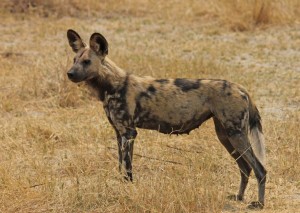
African Wild Dog, scientific name, Lycaon pictus, means painted or ornate wolf. It is called Ajá in Yoruba and used metaphorically in the culture to denote promiscuity, uncritical followership and ill table manner. The fur of L. pictus is short, with little or no underfur, and the blackish skin is sometimes visible where fur is sparse. Typically there is dark fur on the head and a white tip on the end of their bushy tail. They have large, rounded ears, a thin body, and long, muscular legs with four toes on each foot. The body length of Lycaon pictus is between 75 and 110 cm, the tail is between 30 and 40 cm long, and they range in weight for both Male and female, from 18 to 36 kg. Gestation is approximately ten weeks and pups are usually born between March and July. These long-legged canines have only four toes per foot, unlike other dogs, which have five toes on their forefeet. Each animal has its own unique coat pattern, and all have big, rounded ears. The animal show altruistic tendencies and ability to communicate through touch, actions, and vocalization. There are between 3,000 and 5,500 wild dogs, in perhaps 600-1,000 packs, remaining in Africa
There is probably no resident population of wild dogs in Nigeria although occasional vagrants may be sighted. Over most of Nigeria, the situation for large mammals is pretty hopeless, and carnivores are rare throughout. Wild dogs have declined as a result of persecution by hunters and drastic reductions in their prey as a result of poaching. Disease may also be a factor.





















